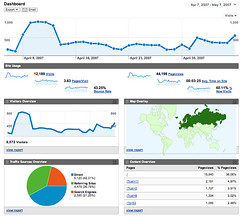According to Google the definition of Bounce Rate is as follows:
Bounce rate is the percentage of single-page visits or visits in which the person left your site from the entrance (landing) page. The more compelling your landing pages, the more visitors will stay on your site and convert.
Google also mentions that Use this metric to measure visit quality - a high bounce rate generally indicates that site entrance pages aren't relevant to your visitors.
Following is the Google Analytics data of one sites for which there was a drastic change in the bounce rate after the site was redesigned. The data proves that a high bounce rate does not necessarily mean a low visit quality and an irrelevant landing page. Especially when it comes to organic search rankings data and data does not lie.
Month | Visits | Page Views | Pages /Visit | Bounce Rate | Average time On Site | % New Visits | Visits From Search engines |
Apr. 2010 | 946 | 4022 | 4.25 | 13.74% | 00:02:35 | 46.83% | 28.44% |
May. 2010 | 1196 | 5484 | 4.59 | 7.69% | 00:02:38 | 58.36% | 33.11% |
June 2010 | 1118 | 4556 | 4.08 | 5.37% | 00:02:12 | 59.93% | 26.30% |
July 2010 | 1238 | 5392 | 4.36 | 7.19% | 00:02:45 | 65.51% | 32.07% |
Aug. 2010 | 1321 | 5498 | 4.16 | 7.72% | 00:02:39 | 66.77% | 26.87% |
Sept. 2010 | 1400 | 5997 | 4.28 | 12.43% | 00:02:38 | 67.21% | 57.07% |
The Website was redesigned and then the metrics were as follows |
Oct. 2010 | 1392 | 3639 | 2.61 | 51.36% | 00:02:42 | 64.01% | 52.16% |
Nov. 2010 | 1255 | 2712 | 2.16 | 58.25% | 00:02:43 | 63.11% | 61.04% |
Google’s definition for bounce rate is more applicable to the PPC (Pay Per Click) data. Especially when it says that a high bounce rate signifies a low relevant or low visit quality.
But if you observe the above case study of a website for organic data or data for organic (SEO) rankings this co-relation does not hold true. If you observe the bounce rate with the old design was low in fact very good but the time spent on the site got divided into 4 pages and time spent on the site is 155 seconds with the visitor spending approx 38 seconds on the site.
After the new design with a more optimized landing page focused on lead generation the average time spent on the site is 160 seconds and the time spent on each page is approx. 80 seconds. The time spent per page is more, in fact doubled so that indicates that the content and design are appealing to the interest of the majority of the visitors.
After the redesign the company got more genuine, targeted and serious online enquiries as the landing page was more geared and focused on lead generation with the contact details available on every page along with a good pleasing design, color combo and content giving a clean, uncluttered professional look . The visit from the search engines show an increasing trend (Majority being from Google – so the rankings are also not affected by the high bounce rate.)
Hence, coming to a conclusion by just observing one metrics in isolation does not convey the right message. Data has to be analyzed in a very cohesive way focusing on what answers have to be sought holistically.
If the landing page is giving the right info. to the visitor and that makes him contact the company for more details and if the contact details are available on that page itself then the bounce rate will be high. But the target of lead generation is achieved so in such cases a high bounce rate need not necessarily be a panic situation.
Nevertheless, in order to keep no stone unturned the bounce rate needs to be decreased by A/B testing or trying out various other tweaks to the site to encourage the visitors to view more pages. As good SEO techniques shall always work to make all the metrics favorable as in many cases Google takes the bounce rate into account to determine the rankings.
These are our observations and conclusions.
Your Comments and your views mean a lot to us. Please share your views on this data .
Labels: Bounce rate, Google Analytics, SEO
 Download the PDF version on http://www.jeffalytics.com/google-analytics-guide/ . Also look out for updates to this in future.
Download the PDF version on http://www.jeffalytics.com/google-analytics-guide/ . Also look out for updates to this in future.







